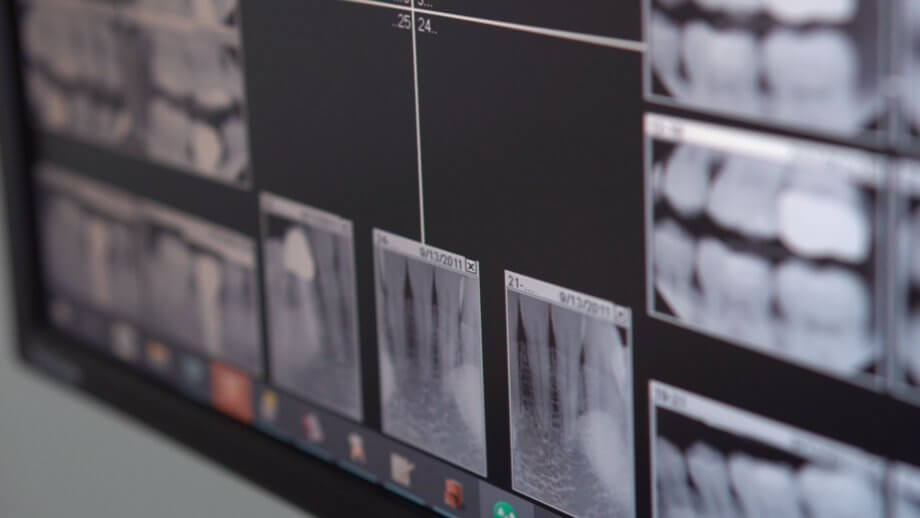Let’s assume that you floss, brush, and rinse daily, and get your teeth cleaned twice per year. If you don’t feel any pain or have any “issues,” are x-rays *REALLY* necessary?
The short answer is YES. The long answer is … still YES!
Dental x-rays enable us to see the tips of your teeth roots and bone underneath your gums (which are not visible to the naked eye). Dental x-rays are used within a routine examination to rule out dental disease, and they also help us diagnose any dental problems you may be experiencing.
How often are they actually needed?
Typically, x-rays are performed yearly. However, oral care needs vary among individuals and some patients may require them more often. Certain factors — age, health, symptoms, and dental history — play a role in the recommended frequency of x-rays for an individual.
Types of x-rays
There are various types of dental x-rays, each of which provide slightly different views of your mouth. They fall under two categories: Extraoral x-rays (jaw and skull) and Intraoral x-rays (tooth, root, and bone). Within these two x-ray types are a wide variety of kinds of x-rays, including:
- Bite-wing. This technique involves biting down on a bite-wing to detect decay between teeth and changes in bone density. Bite-wings are also useful in determining the proper fit of a crown.
- Periapical. This x-ray detects any abnormalities of the root and surrounding bone structure.
- Occlusal. These x-rays show full tooth development and placement. Each x-ray reveals the entire arch of teeth in either the upper or lower jaw.
- Panoramic. For this type of x-ray, the machine rotates around a patient’s head, providing a 360 degree view of the patient’s entire mouth on a single x-ray. Panoramic x-rays are useful for evaluation of anatomical positions, tooth development and detecting the position of emerging and impacted teeth (including wisdom teeth).
- 3D radiography. 3D radiography is highly useful with cosmetic smile design because the 360 degree view offers comprehensive detail for treatment planning. It’s integral in the planning and placement of dental implants and offers a clear view of the anatomy of the tooth and roots for root canal treatment.
Are x-rays safe?
When x-rays are performed, your thyroid, chest, abdomen, and pelvic region will be protected with a lead bib to prevent any unnecessary radiation exposure. A thyroid collar may also be used in certain cases. However, women who are pregnant are advised to delay x-rays until after their pregnancy.
You may be concerned that yearly x-rays increase your cancer risk. In fact, Massachusetts requires strict protocols and inspections that minimize exposure. The benefits of regular x-rays far outweigh the possibility of problems or health concerns.
In fact, we have much greater exposure to radiation in our daily lives than we do at the dentist’s office. Here are some examples:
**To set the bar, keep in mind that the maximum annual dose permitted
for U.S. radiation workers is 50.0 mSv. **
Comparison of radiation exposures
Digital bite-wing x-rays: The radiation exposure from standard digital dental x-rays is very minimal, with a dosage of 0.001 mSv.
Air Travel: A cross-country flight from New York to Los Angeles comes with a dosage of 0.04 mSv. Any flight can come with radiation exposure. Going to Disney World? Expect to be exposed to .0099mSv.
Specific Destinations: Spend a mere three days in Atlanta (or only two days in Denver,) and you will receive the same amount of radiation exposure as you would receive from your annual dental x-rays.
Your Home: Living in a brick, stone or concrete house has an annual dosage of 0.007 mSv. Love your granite countertops? The estimated annual radiation dose from spending four hours daily in a kitchen with granite countertops ranges from 0.005 to 0.18 mSv/a (based on the type of granite).
Foods: The radiation dose you receive from food on an annual basis is equal to about 60 dental x-rays! Here is a list of some of the foods with the highest levels of radiation:
- Brazil nuts
- Lima beans
- Bananas
- White potatoes
- Carrots
- Red meat
- … and even beer!
Within your daily life, you experience small doses of radiation exposure from cell phones, smart watches and household devices. These appliances and devices make our lives easier, safer and more enjoyable. The pros certainly outweigh the cons – as they do for routine dental x-rays.
Next time you are considering skipping your dental x-rays due to radiation exposure, maybe you could skip your family vacation instead. (Just kidding!)
Questions? We are happy to discuss your concerns

